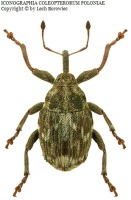Підтримуємо Вільну Україну
 We Support Free Ukraine
We Support Free Ukraine

Biodiversity Map
Taxa

Taxon count: 12
-
Microplontus rugulosus Set as tree root ↑
Show taxon data → ⚑ [99] → Show taxon data
[99] → Show taxon data -
Ceuthorhynchus chrysanthemi Set as tree root ↑
Show taxon data → → Show taxon data -
Ceuthorhynchus figuratus Set as tree root ↑
Show taxon data → → Show taxon data -
Ceuthorhynchus gallicus Set as tree root ↑
Show taxon data → → Show taxon data -
Ceuthorrhynchus rubiginosus Set as tree root ↑
Show taxon data → → Show taxon data -
Ceutorhynchus sartus Set as tree root ↑
Show taxon data → → Show taxon data -
Coeliodes granulicollis Set as tree root ↑
Show taxon data → → Show taxon data -
Curculio cinereus Set as tree root ↑
Show taxon data → → Show taxon data -
Curculio melanostigma Set as tree root ↑
Show taxon data → → Show taxon data -
Curculio subrufus Set as tree root ↑
Show taxon data → → Show taxon data -
Curculio uniguttatus Set as tree root ↑
Show taxon data → → Show taxon data -
Microplontus figuratus Set as tree root ↑
Show taxon data → → Show taxon data
-
Arthropodaphylum
Click to switch
to select orders
and filters > -
Hexapodasubphylum
Click to switch
to select orders
and filters > -
Insectaclass
Click to switch
to select orders
and filters > -
Coleopteraorder
Click to set
as the main taxon
and as a base
← of the left panel > -
Polyphagasuborder
Click to set
as the main taxon
and as a base
← of the left panel > -
Cucujiformiaseries
Click to set
as the main taxon
and as a base
← of the left panel > -
Curculionoideasuperfamily
Click to set
as the main taxon
and as a base
← of the left panel > -
Curculionidaefamily
Click to set
as the main taxon
and as a base
← of the left panel > -
Ceutorhynchinaesubfamily
Click to set
as the main taxon
and as a base
← of the left panel > -
Ceutorhynchinitribe
Click to set
as the main taxon
and as a base
← of the left panel > -
Microplontusgenus
Click to set
as the main taxon
and as a base
← of the left panel >
PL
YES
name status: synonym
BioMap ID: 1050067
taxonomy checked: YES
valid name: Microplontus rugulosus
Data on distribution in Poland

Statistics
- Records: 99
- Publications: 43
- Collections: 2
- Publication authors: 37
- Illustrations (iconography): 1
- Photos (specimen/observation): lacking
Taxon description
Gatunek obejmujący zasięgiem głównie Europę Środkową, sięgający na północ po Danię i południowe obszary Fennoskandii. W Polsce rzadko i sporadycznie znajdowany, notowany z 12 krain, przeważnie z pojedynczych stanowisk w poszczególnych krainach. Zasiedla miejsca kamieniste, nieużytki, przydroża, rowy, zręby i polany leśne. Spotykany od połowy marca do sierpnia na bylicy pospolitej — Artemisia vulgaris L. i bylicy piołunie — A. absinthium L. Według piśmiennictwa larwy żerują prawdopodobnie w łodygach wymienionych roślin.
Illustrations
... browse
 Microplontus
Microplontusrugulosus
External data sources
- Ostatnie rekordy
-
1027889
 ×
× Curculionidae: Microplontus rugulosus, PL, Podlasie, Biebrzański P.N., podlaskie, Biebrzański P.N., Basen Południowy buffer zone, 1996, leg. M. Wanat (Wanat 2005d)
Curculionidae: Microplontus rugulosus, PL, Podlasie, Biebrzański P.N., podlaskie, Biebrzański P.N., Basen Południowy buffer zone, 1996, leg. M. Wanat (Wanat 2005d) -
1027582
 ×
× Curculionidae: Microplontus rugulosus, PL, Pojezierze Mazurskie, Biebrzański P.N., podlaskie, Biebrzański P.N., Basen Środkowy buffer zone, 1996, leg. M. Wanat (Wanat 2005d)
Curculionidae: Microplontus rugulosus, PL, Pojezierze Mazurskie, Biebrzański P.N., podlaskie, Biebrzański P.N., Basen Środkowy buffer zone, 1996, leg. M. Wanat (Wanat 2005d) -
804729
 ×
× Curculionidae: Microplontus rugulosus, PL (Renner et Messutat 2007)
Curculionidae: Microplontus rugulosus, PL (Renner et Messutat 2007) -
804728
 ×
× Curculionidae: Microplontus rugulosus, PL (Mazur 2006d)
Curculionidae: Microplontus rugulosus, PL (Mazur 2006d) -
804726
 ×
× Curculionidae: Microplontus rugulosus, PL (Łętowski et Pawlęga 1998)
Curculionidae: Microplontus rugulosus, PL (Łętowski et Pawlęga 1998) -
804725
 ×
× Curculionidae: Microplontus rugulosus, PL (Cmoluch et al. 1995)
Curculionidae: Microplontus rugulosus, PL (Cmoluch et al. 1995) -
804724
 ×
× Curculionidae: Microplontus rugulosus, PL (Petryszak et Dąbek 1997a)
Curculionidae: Microplontus rugulosus, PL (Petryszak et Dąbek 1997a) -
804722
 ×
× Curculionidae: Microplontus rugulosus, PL (Stachowiak 1994b)
Curculionidae: Microplontus rugulosus, PL (Stachowiak 1994b) -
792386
 ○
○ Curculionidae: Microplontus rugulosus, PL, Pojezierze Mazurskie, Biebrzański P.N., podlaskie, UTM FE13, 1996, leg. M. Wanat (Wanat 2005d)
Curculionidae: Microplontus rugulosus, PL, Pojezierze Mazurskie, Biebrzański P.N., podlaskie, UTM FE13, 1996, leg. M. Wanat (Wanat 2005d) -
786893
 ×
× Curculionidae: Microplontus rugulosus, PL, Wyżyna Małopolska, Łódź, łódzkie, UTM CC93, 1977, leg. M. Wanat (Wanat 1987b)
Curculionidae: Microplontus rugulosus, PL, Wyżyna Małopolska, Łódź, łódzkie, UTM CC93, 1977, leg. M. Wanat (Wanat 1987b) - ... more
- Powiązane publikacje
-
Renner K., Messutat J. 2007. Untersuchungen zur Käferfauna der Umgebung von Skwierzyna im westlichen Polen (Wielkopolska). Coleo, 8:16-20.
 Show records
Show records -
Mazur M.A. 2006d. Weevils (Coleoptera: Curculionoidea: Anthribidae, Apionidae, Curculionidae, Rhynchitidae) of selected excavations of Opole Silesia. [In:] Nowak A., Hebda G. (Eds.) Biodiversity of quarries and pits. Opole Scientific Society, 3rd Department of Natural Sciences, Opole-Górażdże. pp. 145-161.
 Show records
Show records -
Wanat M. 2005d. Ryjkowce (Coleoptera: Curculionoidea bez Scolytinae) Biebrzańskiego Parku Narodowego i jego otuliny. [In:] Dyrcz A., Werpachowski C. (Eds.) Przyroda Biebrzańskiego Parku Narodowego. Osowiec Twierdza. pp. 301-324.
 Show records
Show records -
Mazur M. 2003a. Ryjkowce (Coleoptera: Nemonychidae, Attelabidae, Apionidae, Curculionidae) siedlisk kserotermicznych Polski. II. Szczepanowice koło Miechowa. Wiad. Entomol., 22(3):143-150.
 full text
full text Show records
Show records -
Łętowski J., Pawlęga K. 1998. Ryjkowcowate (Curculionoidea: Attelabidae, Apionidae, Curculionidae) roślinnych zbiorowisk śródmiejskich Sandomierza. Ann. UMCS, C, 52:197-218.
 Show records
Show records - ... more
- Powiązane zbiory
-
Mazur M.A.
 Show records
Show records -
Wanat M.
 Show records
Show records
- Wykaz powiązanych pozycji
-
Curculionoidea of Poland
 Show records
Show records



